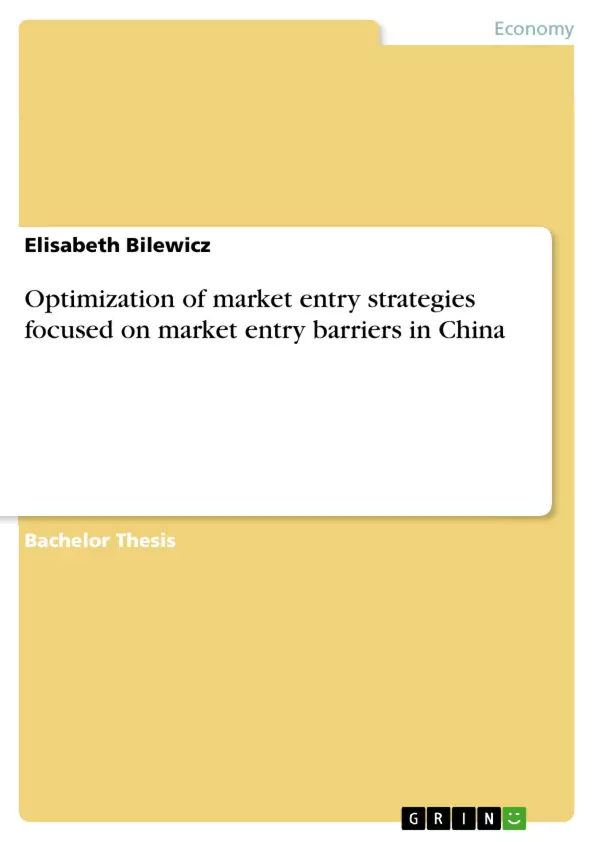Which possibilities does a company have to go abroad?
What kinds of barriers have to be taken into consideration when entering foreign markets?
These are major questions that affect enterprises when they plan the expansion of their business into a foreign environment.
This present bachelor thesis is concerned with market entry barriers that have an impact on the chosen market entry strategy of a company. It wants to help sensitizing for potential problems that can occur when entering a foreign market and show which barriers have to be heeded even if the chosen market offers respectable growth as the chosen Chinese economy does.
From this examination of potential market barriers it is the objective of this thesis to help identify improvements for market entry strategies and thereby increase the likelihood of a successful venture.
Inhaltsverzeichnis (Table of Contents)
- Introduction
- Executive Summary
- Scope of work
- Problem definition and Research methods
- Definition of Problem
- Reasoning and Motivation
- Research methods
- Primary Research
- Secondary Research
- Methods used in Thesis
- Theories
- Relevant theories for market entry strategies
- Export
- Indirect Export
- Direct Export
- Licensing
- International Franchising
- Joint Ventures
- Overseas branches and factories
- Subsidiaries
- Selected theory for market entry strategy
- Definition of Joint Ventures
- Types of Joint Ventures
- Equity Joint Ventures
- Contractual Joint Ventures
- X-Joint Ventures and Y-Joint Ventures
- Critical comment on Joint Ventures
- Relevant theories for market entry barriers
- Porters Industry Analysis
- The SWOT analysis
- Hofstede's cultural value dimensions
- Selected theory elements for market entry barriers
- Elements of SWOT analysis
- Weaknesses
- Threats according to Porter
- Use of SWOT analysis
- Critical comment on SWOT analysis
- Elements of Hofstede's cultural value dimensions
- Power Distance
- Uncertainty Avoidance
- Individualism versus Collectivism
- Long term-orientation versus short-term orientation
- Critical view on Hofstede's cultural value dimensions
- Optimization of market entry strategies for China
- Market entry barriers in the Chinese market
- Joint Ventures as a strategic approach to market entry
- Application of SWOT analysis for identifying strengths, weaknesses, opportunities, and threats
- The role of cultural dimensions in influencing market entry success
- Introduction: This chapter introduces the topic of market entry strategies, focusing on the Chinese market and the challenges associated with it. It provides an overview of the thesis scope, research objectives, and methodology.
- Problem definition and Research methods: This chapter delves into the specific problem statement, outlining the research questions and explaining the chosen research methods. It outlines the rationale behind selecting primary and secondary research, and how they will be employed in the thesis.
- Theories: This chapter provides a comprehensive overview of relevant theories related to market entry strategies and market entry barriers. It explores different approaches like export, licensing, franchising, joint ventures, and subsidiaries, along with a critical analysis of each. This chapter also examines theories on market entry barriers such as Porter's Industry Analysis, SWOT analysis, and Hofstede's cultural value dimensions.
- Case: This chapter presents a case study focused on Siemens in China. It provides an economic framework of the Chinese market, exploring geographic, social, legal, and market development factors. The chapter also offers a detailed profile of Siemens in China, highlighting its presence, key departments, and previous market entry experiences.
- Application of Relevant Theory elements onto Case: This chapter applies the theoretical concepts introduced earlier to the Siemens case study. It examines the use of Joint Ventures in China as a market entry strategy, evaluating the SWOT analysis framework and its implications for Siemens. It also investigates the role of Hofstede's cultural value dimensions in understanding the Chinese context and navigating potential cultural differences.
- Application of Research methods onto Case: This chapter outlines the structure and results of expert witness interviews conducted as part of the primary research for this thesis. The insights gained from these interviews provide valuable perspectives on the challenges and opportunities of market entry in China, specifically for Siemens.
- Solution of Case Problem: This chapter synthesizes the findings from the case analysis, providing a proposed solution to the identified problem. It outlines specific recommendations and strategies based on the theoretical framework and empirical research.
Zielsetzung und Themenschwerpunkte (Objectives and Key Themes)
This bachelor thesis investigates the optimization of market entry strategies with a focus on market entry barriers in China. The study aims to analyze relevant theories and apply them to a real-world case study of Siemens in China. It explores the use of Joint Ventures as a market entry strategy and examines the applicability of SWOT analysis and Hofstede's cultural value dimensions to identify and address potential challenges.
Zusammenfassung der Kapitel (Chapter Summaries)
Schlüsselwörter (Keywords)
This bachelor thesis focuses on the optimization of market entry strategies in the Chinese market. Key concepts include market entry barriers, Joint Ventures, SWOT analysis, Hofstede's cultural value dimensions, and the case study of Siemens in China. The thesis aims to provide practical insights into navigating cultural challenges and maximizing market entry success in a rapidly growing and complex market.
- Arbeit zitieren
- Elisabeth Bilewicz (Autor:in), 2006, Optimization of market entry strategies focused on market entry barriers in China, München, GRIN Verlag, https://www.grin.com/document/61256



